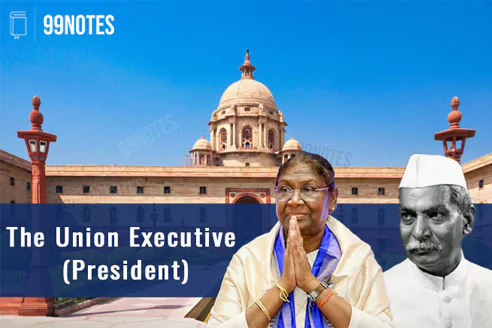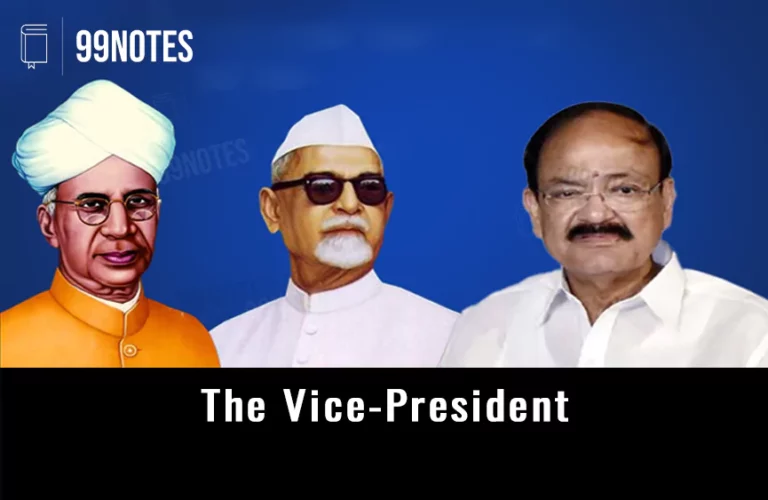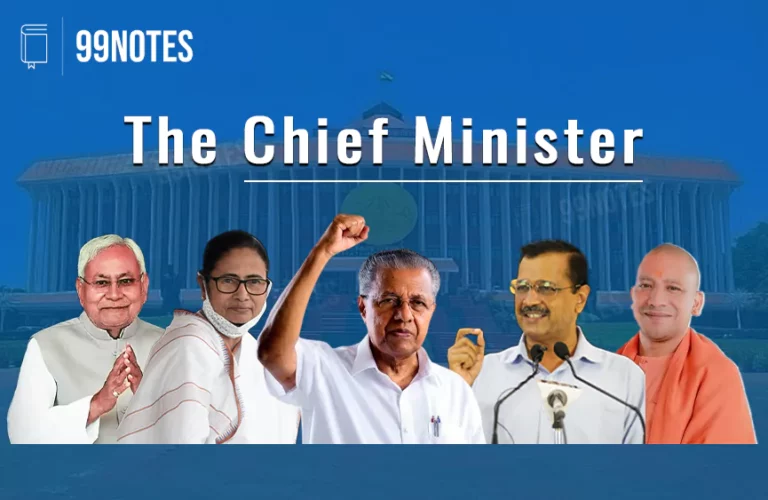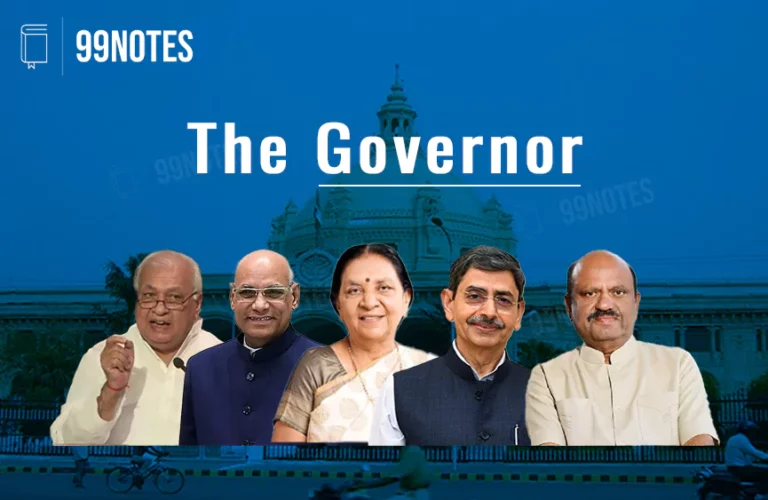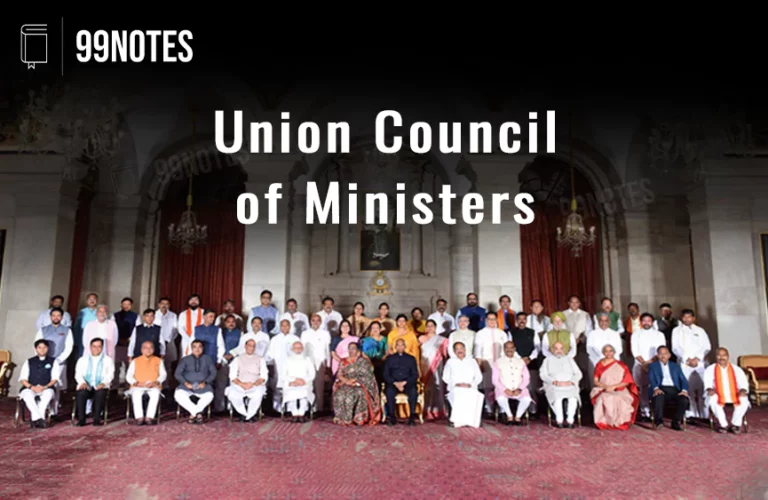President of India (Article 52-62) – UPSC Indian Polity Notes
The Parliamentary system of government is characterised by the presence of dual executives. The Union executive consists of the President, the Prime Minister, the Council of Ministers and the attorney general of India. The executive power of the government of India is vested in the President of India, who is the head of the Indian state.
The Constitution of India, however, gives only the ceremonial position of the President, with no real authority. The real executive power rests with the Prime Minister. While the President is the head of the state, the Prime Minister is the head of the government. Articles 52 to 62 deal with the president of India.
President of India
The President is considered to be the first citizen of India. S/he carries out the functions of the government only with the aid and advice of the Council of Ministers.
Election of the President
The President of India is not elected directly by the people of India but by an electoral college which includes [Article 54]:
- the elected representatives of both houses of Parliament;
- the elected members of state legislative assemblies;
- the elected members of the legislative assembly of the Union territory of Delhi, Puducherry Jammu and Kashmir (J&K Assembly not constituted yet).
| The 104th Constitutional Amendment Act discontinued the nomination of Anglo-Indians in the Loksabha and state legislative assemblies. |
The nominated members of Loksabha, Rajya Sabha and State assemblies are not eligible to vote in the elections for President of India.
Qualifications of President of India
The requisite qualifications for the election of the President of India are:
- S/he is a citizen of India:
- S/he has completed the age of 35 years;
- S/he is qualified to be elected as a member of Loksabha;
- S/he should not hold any office of profit under the Union Government or any State Government. However, the Office of the President, the Vice President, the Governor or the Ministers of Union or State is not considered as an office of profit.
- Further, the nomination of a candidate for the election of the President must be backed by at least 50 electors as proposers and same number of electors as seconders.
- The candidate also has to deposit a sum of ₹15000 in the Reserve Bank of India.
President Election Process in India
The election of the President of India is held using the system of proportional representation by means of a single transferable vote and voting by secret ballot. It is managed by the Election Commission of India.
India is a Republic where the head of the state has to be a representative of the people. Therefore, the President’s election is designed in such a way as to ensure uniformity among states and parity between the Centre and the states, and each citizen is equally represented in the election through their legislators. [Article 55]
Proportional Representation System: For this purpose, the number of votes that each elector casts in such an election shall be determined in the following manner:
- Value of the vote of an MLA: The value of a member of the state legislative assembly is derived by dividing the total population of the state by the total number of elected members in the assembly. The quotient obtained is divided by 1000 to get the value of the vote of each member of the assembly in the presidential election.
- Value of vote of an MP: The value of the vote of a Member of Parliament is derived by dividing the total number of votes given to all the elected members of the state assemblies by the total number of elected members of both the houses of the Parliament.
 Electoral Quota: The winning candidate must secure more than 50% of the total valid votes polled. This amount of vote is called the ‘Electoral Quota’. This quota is obtained by dividing the total number of valid votes polled by number of candidates to be elected (1) plus one and adding one to the quotient (i.e. 2).
Electoral Quota: The winning candidate must secure more than 50% of the total valid votes polled. This amount of vote is called the ‘Electoral Quota’. This quota is obtained by dividing the total number of valid votes polled by number of candidates to be elected (1) plus one and adding one to the quotient (i.e. 2).

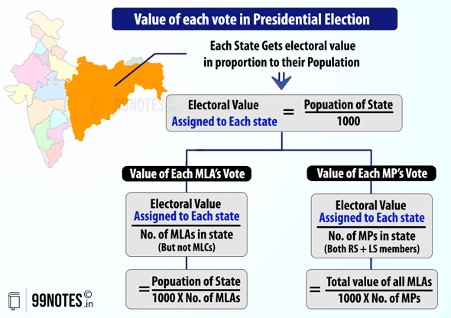 Single transferable Vote System: As per this system, while casting a vote, the electors are required to indicate their preference by marking 1, 2, 3, etc., against the names of the candidates.
Single transferable Vote System: As per this system, while casting a vote, the electors are required to indicate their preference by marking 1, 2, 3, etc., against the names of the candidates.
- In the first phase of counting, only the first preference votes are counted. If a candidate has secured 50% of votes in the first count, s/he is declared elected.
- Otherwise, the candidate who receives the least first preference votes is eliminated from the race and his/her votes are distributed among the remaining candidates according to the second preference marked on these ballot papers.
- This redistribution of votes continues until one candidate secures the electoral quota.
Note-1: It is not mandatory to fill out more than one preference; an elector can provide a single preference as well.
Note-2: So far, since Independence, the second preference votes have been counted once.
Resolution of disputes regarding the President’s election: All disputes and queries about the election of the President are attended by the Supreme Court, and its decision is final. If the election of a sitting President is declared void by the Court, acts done by him before such declaration remain valid.
The rationale behind the indirect election of the President: Some of the members of the Constituent Assembly were not in favour of indirect elections for not being democratic and proposed a direct election. However, the Constitution provided for indirect elections for the following reasons:
- The indirect election of the President is in line with the Parliamentary form of government where the President is only the ceremonial head, with no real authority.
- Direct election throughout the Country is an expensive and time-consuming process. It would be imprudent to invest so much resources, given the ceremonial position of the President.
Oath and affirmations by the President of India
Every elected President or person acting as President of India must take oath before entering upon his/her Office, in the presence of the Chief Justice of India (CJI) (or in his absence, the senior-most judge of the Supreme Court) in the following form:
Conditions to the President’s Office
The Constitution has laid down the following conditions with respect to the Office of the President of India:
- S/he should not be a member of Parliament or state assembly. If any such person is elected as the President, his/her seat is deemed to be vacant the day s/he enters his/her Office.
- S/he is entitled to use Rashtrapati Bhavan as his/her official residence without payment of rent.
- S/he is entitled to such remunerations, allowances and privileges as may be fixed by the Parliament.
- His/her emoluments cannot be diminished during his/her term. In 2018, the President’s salary was increased from 1.5 lakh to 5 lakh per month.
Privileges and Immunities enjoyed by the President:
- The President of India enjoys immunity from legal liabilities for his official acts.
- S/he cannot be arrested or imprisoned during the term of his/her Office; however, civil proceedings can be initiated against him/her after giving two months’ notice.
Term of President’s Office
The term of the President’s Office is 5 years from the date s/he assumes Office. The President is eligible for re-election for any number of times. The President can resign from the Office at any time by writing the resignation letter to the Vice-President. Further, the President can be removed from Office through the process of impeachment.
Impeachment of the President
Articles 56 and 61 of the Indian Constitution provide for the impeachment of the President of India on the grounds of violation of the Constitution.
- The resolution of the impeachment can be moved into any of the houses of the Parliament.
- It should be moved by at least 1/4th of the members of the house, and a 14-day notice should be given to the President.
- The resolution must be passed by not less than 2/3rd majority of the total members of the house.
- After the resolution is passed in one house, it is moved to the second house for investigation.
- The President is allowed to defend himself/herself either personally or through his/her counsel.
- If the second house investigates the charges and passes the resolution by the 2/3rd majority of the house, then the impeachment process completes, and the President stands removed from his/her Office on the date of passing of the resolution.
Vacancy in the President’s Office
A vacancy in the President’s Office can arise in the following instances:
- On the expiry of his/her term
- By his/her resignation
- By his/her removal through the process of impeachment
- When s/he is disqualified for the Office or when his/her election is declared void
- By his/her death during the term
Immediate Filling of Presidential Vacancy before end of term
The election for the new term of the President of India must be conducted before the expiry of the current term.
- In case there is a delay in the election, the present President continues to hold the Office. This provision was made to avoid ‘interregnum’ (a pause or interval between two periods of Office). In this case, the Vice President does not get to act as the President.
- In case of the President’s resignation, death, or removal, the election for the President’s Office must be conducted within 6 months of such occurrence. The newly elected President holds the Office for a full term of 5 years.
- When a vacancy occurs in the President’s Office due to removal, death or resignation, the Vice President acts as the President until a new President is elected. The Vice President also acts as President in cases of absence of the President, illness or any other cause.
- In case the Office of the Vice President is also vacant, the Chief Justice of India or, in his/her absence, the senior-most judge of the Supreme Court acts as the President and discharges all functions. In this period, s/he is entitled to all the powers and immunities enjoyed by the President and is entitled to such remunerations, allowances and privileges as determined by the Parliament.
Powers and Functions of the President
Being the head of the state, the President of India is the head of the Union executive, a part of the Indian Parliament. The Constitution of India enumerates two powers of the President:
- Executive powers of the President under Article 54, and
- Legislative powers of the President under Article 123.
However, Article 74 says that the President has to act according to the aid and advice of the Council of Ministers headed by the PM. Thus, all powers of the President are really the power of the government headed by the PM.
Amendments in Article 74 |
| Article 74 in the original Constitution simply read: “There shall be a Council of Ministers with the Prime Minister as the head to aid and advise the President”.
42nd Constitutional Amendment added: “who shall, in the exercise of his functions, act in accordance with such advice”. 44th Constitutional Amendment further added: “Provided that the President may require the Council of Ministers to reconsider such advice, either generally or otherwise, and the President shall act in accordance with the advice tendered after such reconsideration”. |
Nevertheless, in some situations, the President enjoys discretion, such as the appointment of the PM, dismissal of the government/dissolution of Lok Sabha in case of No-confidence and Veto Power, which we shall discuss later.
Also, as the nominal head, the President enjoys various privileges:
- S/he is the nominal head of the government, and all executive decisions are taken in the President’s name.
- The President is a part of the Parliament [Article 79] and addresses the first session after a general election and the first session of the Parliament (joint session) each year.
- The President of India is the Supreme Commander of the defence forces.
- International treaties and agreements take place in the name of the President.
- President has the right to be informed: S/he can seek any information from the Prime Minister regarding the administration of the state.
- S/he can call for the PM to submit, for the consideration of the Council of Ministers, any matter on which a decision has been reached by a minister but which has not been discussed by the Council.
1. Executive Powers of President of India
Executive powers refer to the power to carry out the business of the government and the administration of the state’s affairs. The Constitution vests all the executive powers of the Union in the President (Article 53).
As discussed above, these are not exercised by the President’s discretion alone. Thus, the executive powers of the President are the powers of the government.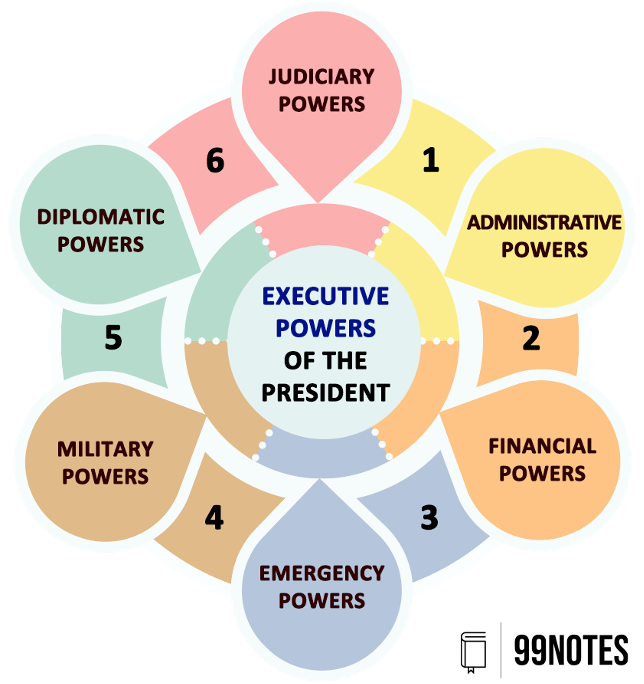
2. Administrative Powers of president in India:
The government has the power to decide in the matters of everyday administration as follows:
- Power to make rules:
- The President makes the rules, specifying the manner in which the orders and other instruments executed in his/her name shall be authenticated.
- S/he makes the rules for the convenient business of the Union government and allocates the said business to the ministers.
- For example, the Transaction of Business Rules, 1961, was made by the government for the smooth functioning of the government.
- Power of appointment and removal:
- S/he appoints the Prime Minister of India and other ministers. All ministers hold their offices at the President’s pleasure (Government’s pleasure).
- The President also appoints various chairpersons of Constitutional bodies like the Attorney General of India, the Comptroller and Auditor General of India (CAG), the chairman and the members of the Union Public Service Commission, Chief Election Commissioner of India as well as other Commissioners, the chairman of the Finance Commission, the Governor of the states and so on.
- S/he Can appoint a commission to investigate the conditions of SCs, STs, and OBCs.
- Federal Powers:
- Can set up an Inter-state council for federal cooperation.
- The President administers the union territories with the help of administrators appointed by him/her.
- The President can declare any area as scheduled and has powers related to the administration of scheduled and tribal areas.
3. Financial Powers of President of India
The President possesses the following Financial Powers:
- No money bill can be introduced in the Lok Sabha without the prior permission of the President.
- No demand for a grant can be made except on the President’s recommendation.
- S/he makes sure that the annual financial statement (Union budget) is laid before both houses.
- S/he can authorise advances out of the Contingency fund of India to meet any unexpected expenditure.
- S/he constitutes a Finance Commission every five years to recommend the distribution of taxes between the Centre and states.
4. Judicial Powers of President of India
The President possesses the following judicial powers:
- The President appoints the judges of both Supreme Court and High Courts.
- S/he can seek advice from the Supreme Court over any issue of law or public importance (Article 143).
The pardoning power of the President
The Constitution, under Article 72, has empowered the President of India to grant pardons, etc., to the persons who have been tried and convicted of any offences in cases of:
- Punishment or sentence under a Union law;
- Punishment or sentence by Court Martial; and
- Death sentence (both under Union laws and state laws)
The pardoning powers of the President include the following:
- Pardon: It not only ends the sentence but also completely absolves the convict from all sentences, punishments and disqualifications.
- Commutation: Under this, a particular sentence can be substituted for a less harsh sentence. For example, a death sentence can be commuted to rigorous imprisonment.
- Remission: Under this, the period of a particular sentence can be reduced. For example, imprisonment of 5 years can be reduced to 3 years.
- Respite: It means awarding a lesser sentence in place of the original one, considering the physical disability of the convict.
- Reprieve: It means a stay of the execution of a sentence (especially a death sentence) for a temporary period of time. It allows the convict to seek pardon or commutation from the President.
| Conviction | Sentence | |
| Pardon
(Forgiving an offence) |
Removed – Person absolved from all charges | Removed – President Pratibha Patil Pardoned as many as 30 during her tenure. |
| Commutation
(Reduction of a sentence, especially death) |
Stands | A lighter form of punishment – changing the character of the sentence. For example, the commutation of a death sentence to rigorous imprisonment |
| Remission
(Refraining from inflicting punishment or a debt.) |
Stands | Reduction of sentence without changing character. For example, A 20-year life imprisonment is reduced to a 14-year life imprisonment. |
| Respite
(A period of rest/relief) |
Stands | Leniency shown – Lesser sentence due to a special fact – disability or pregnancy of a female offender |
| Reprieve (delaying punishment to enable the convict to seek other legal remedies) | Stands | Stands – but temporarily suspended |
The rationale behind pardoning power: To keep the possibility of rectifying any judicial errors and to provide relief from the sentence that the President regards as unduly harsh. However, there is a possibility of its misuse for political considerations.
Thus, the Judicial powers of the President of India are actually administrative in nature. This is also because the convict does not have a right to be heard before the President.
5. Emergency Powers of the President
The Constitution confers extraordinary powers to the President to deal with the following types of emergencies:
- National Emergency (Article 352);
- Financial Emergency (Article 360);
- President’s Rule (Article 356)
6. Diplomatic and Military Powers of President of India
- International treaties and agreements are negotiated and signed in the name of the President.
- The President represents India in International forums and bilateral visits and sends and receives diplomats like ambassadors, high commissioners and so on.
- The President is the Supreme Commander of the defence forces of the Country and appoints the chiefs of the army, the navy and the air force.
- The government, through the President, can declare war or conclude a peace deal, subject to the approval of the Parliament.
7. Legislative Powers of President
The President of India is a part of the Parliament along with the House of People (Lok Sabha) and the Council of States (Rajya Sabha) (Article 79).
The Constitution explicitly mentions only one legislative power under the chapter “Legislative power of the President”: The President is empowered to promulgate ordinances when the Parliament is not in session and can withdraw it anytime. [Article 123]
However, there are a host of powers that are vested in the President in various other articles, that are exercised with the aid and advice of the Council of Ministers. The President can:
- Summon and prorogue the Parliament and dissolve the Loksabha. She can also summon a joint sitting of both houses in case of a deadlock.
- Send a message to the Parliament regarding a pending bill.
- Appoint any member of the lower house (Lok Sabha) to preside over the house when the Office of both the speaker and the deputy speaker is vacant. The President can exercise similar power in the case of Rajya Sabha, too.
- Nominate 12 members to the upper house from amongst the persons of eminence in the fields of literature, science, art, and social service.
- Decide on the disqualifications of the members of the Parliament with consultation from the Election Commission of India.
- His/her prior recommendation and permission are required to present certain types of bills. For example – A money bill is a bill meant for state reorganisation of a state/s.
- The President can make regulations for the peace, progress and good governance of the UTs of Andaman and Nicobar Islands, Lakshadweep Islands, and now merged Dadra and Nagar Haveli and Daman and Diu.
8. Giving Assent to a bill:
Finally, the President of India has the discretion to give Assent to a bill, after which it can become law.
Following are the Provisions related to the ratification of the bills of both Parliament and state legislature by the President:
- When a bill is passed by the Parliament, it is then sent to the President for his/her Assent. In such cases, the President has the following options (Article 111):
-
- Declare Assent to the bill
- Declare to withhold the Assent (Absolute veto)
- Return the bill (except a Money bill) for reconsideration by the Parliament. However, if the bill is passed by the Parliament again by the same majority, the President has no option but to give Assent to the bill (Suspensive veto).
However, since there is no time limit given to either declare the Assent or withhold, the President can keep the bill undecided forever. (Pocket Veto)
- Further, when the Governor reserves a bill passed by the state legislature for the President’s consideration, the President has the following options (Article 201):
-
- Give Assent to the bill
- Withhold the Assent (Absolute Veto)
- Can direct the Governor to send the bill back (If it is not a money bill) for the reconsideration of the state legislature. Even if the state legislature passes the bill again and it is sent for the President’s consideration, the President is not obliged to give Assent. It means the President enjoys absolute veto over state bills. (Suspensive veto).
24th Amendment, 1971 |
| The 24th Amendment Act of 1971 made it obligatory for the President to give his/her Assent to a constitutional amendment bill. |
9. Veto Power of the President of India
The Veto power of the President refers to the power through which he/she can stop a bill from becoming a law. The veto power, in general, can be classified into the following types:
- Absolute Veto: It means refusing Assent altogether. In the Indian context, an Absolute Veto is Possible:
-
- With respect to private member’s bills.
- When the government falls before the Presidential Assent, and the new government advises the President not to give Assent to such bills.
- The government can advise the President to withhold Assent to its own bill, too.
- Suspensive Veto: This type of veto is exercised when the President returns the bill for reconsideration.
-
- Case of Ordinary Bill: If the Parliament passes the bill again (with or without amendments), the President is obliged to give Assent. It means the Parliament can override the Presidential veto by re-passing the bill by the ordinary majority. (In the USA, such an override requires passing the bill by a higher majority; it is known as a Qualified Veto).
- This provision does not apply to the Money bill; here, the President can either give Assent or withhold the bill.
- Pocket Veto: It means taking no action on the bills passed by the legislature. Since there is no time limit to decide on the Assent, it gives power to the President to veto a legislation indefinitely.
-
- An ordinary bill, as well as a Money bill in India, can remain pending for an indefinite period (Unlike the USA, where the President has to return the bill within 10 days).
The Veto power of the President is a discretionary power, i.e. it can be exercised without the aid and advice of the Council of Ministers. But the Council of Ministers too can advise the President on this matter.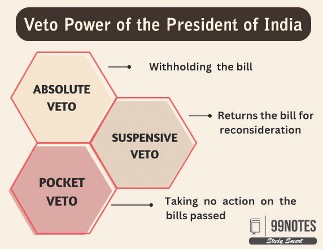
Constitutional Position of the President
The Constitution provides for a Parliamentary form of government in which the President only has a nominal and ceremonial position. The President exercises his powers and functions on the aid and advice of the Council of Ministers.
- Dr BR Ambedkar outlined the position of Governor in the following way, “He is the head of state but not of the executive. He represents the nation but does not rule the nation. He is the symbol of the nation. His place in the administration is that of a ceremonial device or seal by which the nation’s decisions are made known.
- Former President R Venkataraman called himself a “copy-book President”. He was President when the era of coalition politics started. On the question of whether the President should have discretionary power, he stated that “President is like an emergency lamp which comes to power when the main switch is off”.
- Constitutional Amendments which affected the position of the President:
-
- 42nd Constitutional Amendment 1976: This Amendment settled the position of President as the Constitution makers envisaged it. It made the aid and advice of the Council of Ministers binding on the President.
- 44th Constitutional Amendment Act 1978: This Amendment partially restored the discretion of the President and provided that the President can ask the Council of Ministers to reconsider its proposal. However, the President is bound to act on the reconsidered advice.
- 24th Constitutional Amendment 1971: This Amendment made it obligatory for the President to provide Assent to a Constitutional Amendment Act.
Is the President of India a Mere Rubber Stamp?
The position of President of India is a position of dignity; it is the highest Constitutional Office. It is comparable to the British Monarch. But the Indian Monarch is not merely a rubber stamp.
- President is Democratically Elected: Unlike the Monarch in Britain, the President of India is elected by an electoral college representing every corner of the Country. In fact, the PM in India is elected only by the members of Lok Sabha, whereas the electoral college of the President is much wider and includes all Parliamentarians and the MLAs. Thus, the President has a larger representative character.
- In the era of coalition governments, there are some grey areas in which the President acquires some situational discretions, such as:
-
- Appointment of the Prime Minister when no party secures the required majority or in case of the death of the Prime Minister.
- Dismissal of the Council of Ministers when it cannot prove its confidence in the Lok Sabha.
- Dismissal of Lok Sabha, when the ministry has lost its majority.
- Further, the Indian President has the power to veto legislation, whereas, in Britain, royal Assent is only a formality.
- He has a constitutional duty to preserve the Constitution: The Oath of the President reads that “I shall Preserve, protect and defend the Constitution” and is impeached only upon the “violation of the Constitution”. A similar duty is not awarded to the British Monarch.
In this context, Granville Austin had described the President’s position in the following manner,” The President of India has no real political powers, but it is a tremendous platform for the expression of ideas. He is a symbol of national identity, unity and integrity, and his Office to be not lightly regarded.”
To sum up, we can say that the Constitution envisages a “Constitutional President” and not a rubber stamp.
Other Related Links:
| Vice President | Prime Minister |
| Union Council of Ministers | The Governor |
| Chief Minister | State Council of Ministers |

